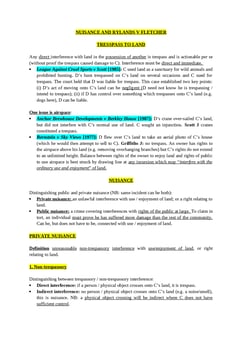Murphy v Brentwood DC [1991] 1 AC 398
Judgement for the case Murphy v Brentwood DC
KEY POINTS
Economic loss caused by defects in a building was not recoverable in negligence.
The local authority could not be held liable for negligence in this case, departing from the Anns ruling, which had established a two-stage test for determining whether a local authority owed a duty of care in relation to building inspections and approvals.
Overruling the Anns test, the court opined that it should not be applied too broadly and that policy considerations should limit the scope of liability.
FACTS
ABC Homes constructed an estate in Brentwood with 160 houses, including houses numbered 36 and 38 Vineway. These two houses were built over filled ground using a concrete raft foundation designed by Grahame Rudkins Associates. The design was submitted for approval to the appellant council under the Public Health Act 1936. The council sought advice from independent consulting engineers, Messrs. S. D. Mayer & Partners, who approved the design. The plaintiff bought house 38 Vineway in 1970.
The house's interior walls started to show noticeable fractures starting in 1981, and the grass started to develop moist patches. According to investigations, the concrete raft had differentially subsided, resulting in distortion and cracking. The plaintiff was faced with a number of damages, including a broken soil pipe going to the main drain and a broken gas line.
The plaintiff's next-door neighbor also sustained harm as a result of settlement. Due to structural problems, the plaintiff chose to sell the home and did so in 1986 for £30,000, a considerable discount from the home's £65,000 market value prior to the faults. An insurance claim for subsidence damage was settled for £35,000 by Norwich Union, the plaintiff's carrier.
The damages claimed against the council included the settlement amount, costs related to selling the house and buying a new one, refitting carpets, and replacing the gas pipe. The estimated cost of remedial work on the foundation was approximately £45,000.
JUDGEMENT
Appeal allowed.
COMMENTARY
Murphy v Brentwood District Council is a pivotal case in English tort law, particularly in the field of negligence and the liability of local authorities. It clarified the limits of liability for professional advice and emphasized the importance of policy considerations in determining whether a duty of care exists. This decision has had a lasting impact on the law of negligence in the UK.
ORIGINAL ANALYSIS
Plaintiff bought a house that turned out to be faulty. Since they couldn’t afford the repairs, they had to sell it at a price considerably less than that which they paid to a person who was living in the house unrepaired at the time of the case.
They sued Defendant (the local authority who authorised the building of the houses) for negligence.
HL refused their claim. HL explicitly overruled the outcome in Anns (that a public inspector had a duty of care to purchasers of a property to see that it was built properly). It also rejected the complex structures theory.
Lord Keith
There was no duty to take reasonable care to avoid causing pure economic loss. The only instance where economic loss is compensable is in the Hedley Byrne line of cases. Anns was a bad decision since it has opened the floodgates.
Also to allow the builder/person who authorised the works to be liable for economic loss is inconsistent with the general rule that the manufacturer of chattels is not liable for economic loss (which is a good rule for avoiding floods of claims).
Lord Bridge
If the defect in a chattel causes economic loss (rather than physical problems as in Donoghue) a manufacturer cannot be held liable, even if the thing is defective to the point of being worthless. Liability here is for contract to determine.
This is because there is no proximity between Plaintiff and manufacturer regarding loss (HE is confusing proximity and remoteness i.e. that the type of harm is reasonably foreseeable. However the point about inconsistency is true and perhaps manufacturers should also be liable for economic loss). The principle is equally applicable to buildings.
-
He also says, regarding Junior Books: “there is a special relationship of proximity between builder and building owner which is sufficiently akin to contract to introduce the element of reliance so that the scope of the duty of care owed by the builder to the owner is wide enough to embrace purely economic loss. The decision in Junior Books Ltd v. Veitchi Co. Ltd. can…only be understood on this basis.”
I.e. he confines it by saying that it basically comes within the Hedley Byrne principle but with negligent misperformance, not misstatement. This prevents it having general effect.
----
Weir argues that this conclusion is correct for a number of reasons:
No proximity between authority and plaintiff;
Inconsistency regarding manufacturers;
Floodgates.
RELATED CASES
For Further Study on Murphy v Brentwood DC
Need instant answers? Our AI exam tutor is here to help.
Ask questions 🙋 Get answers 📔 It's simple 👁️👄👁️
Our AI is educated by the highest scoring students across all subjects and schools. Join hundreds of your peers today.
Get StartedSimilar Cases
Related Product Samples
These product samples contain the same concepts we cover in this case.

